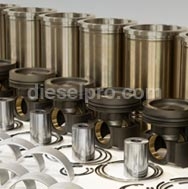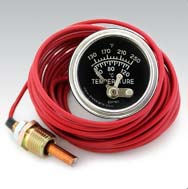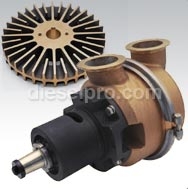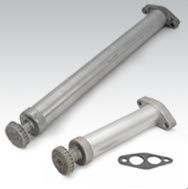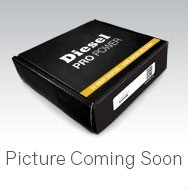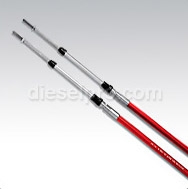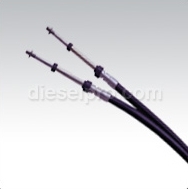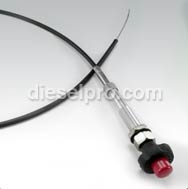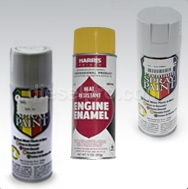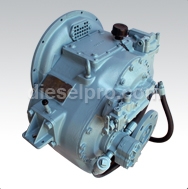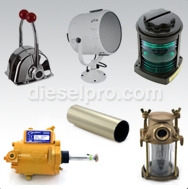The Caterpillar 3512 engine is a heavy-duty, V-12, four-stroke diesel engine known for its high power output, durability, and adaptability across numerous industrial and marine applications. As part of the renowned 3500 series from Caterpillar, the 3512 stands out for its robust architecture, modularity, and long service life. It is engineered for maximum uptime in the most demanding environments — from offshore drilling platforms to standby generators and marine propulsion systems. With its formidable displacement of 51.8 liters (3,159 cubic inches) and a power output range often exceeding 1,000 to 2,250 horsepower depending on configuration, the 3512 is a trusted solution for operators requiring scalable power and reliability. Specification Detail Engine Model Caterpillar 3512 Engine Family 3500 Series Configuration V-12, 4-stroke diesel Displacement 51.8 L (3,159 cu in) Bore and Stroke 170 mm x 190 mm (6.69" x 7.48") Aspiration Turbocharged and Aftercooled Cooling System Jacket Water and Aftercooler Compression Ratio 13.0:1 (typical) Fuel System Unit Injection or EUI Governor Type Electronic or Mechanical Rated RPM Range 1200 – 1900 RPM Power Output Range 1,000–2,250 HP (varies by config) The 3512 is available in numerous submodels, including the 3512B, 3512C, and 3512E, with enhancements in emissions compliance (e.g., EPA Tier 2/3, IMO II/III) and control systems. However, this page focuses specifically on the original Caterpillar 3512 engine and its core mechanical configuration. One of the standout characteristics of the Caterpillar 3512 engine is its exceptional low-end torque. This is especially valuable in marine propulsion and industrial load applications where immediate pulling power is necessary. The engine is designed to deliver consistent torque across a wide RPM range, allowing vessels to maneuver reliably in tight harbor conditions and allowing industrial machines to maintain productivity under load stress. The turbocharging and aftercooling systems on the 3512 maximize combustion efficiency and air-to-fuel ratios. This translates to more horsepower per gallon of diesel fuel, lower exhaust gas temperatures (EGTs), and extended engine component life. These systems are vital in high-demand environments such as continuous-duty marine propulsion or stationary power generation, where heat management is crucial for long-term operation. For critical operations such as offshore platforms and defense vessels, redundancy is a necessity. The 3512 engine supports dual starting motors, dual oil filters, and redundant fuel lines, making it a favorite in environments where failure is not an option. This design philosophy extends uptime and builds resilience into the core architecture of the engine. Unlike monoblock designs, the 3512 engine utilizes individual cylinder heads. This allows technicians to service or replace one cylinder at a time without needing to dismantle the entire top-end of the engine. The result is significantly lower downtime, easier diagnostics, and reduced repair costs — especially critical in remote installations like marine vessels or oilfield equipment. While many early 3512 engines used mechanical governors, later configurations are compatible with advanced electronic engine control modules (ECMs). These allow for real-time data monitoring, precise fuel metering, load optimization, and emissions adjustments. Operators benefit from improved fuel efficiency, detailed diagnostic reporting, and integration with remote control systems or SCADA platforms. The 3512 was built during an era when engine manufacturers emphasized long-term durability, but it also holds its own in the area of fuel economy. With optimized combustion and electronically controlled injectors in newer variants, the engine can achieve brake specific fuel consumption (BSFC) figures in the range of 0.32 to 0.34 lbs/HP-hr — competitive for a 50+ liter engine in its class. Its efficiency is further enhanced by: Efficient turbochargers that recover waste exhaust energy Precision injectors that reduce unburned fuel Aftercooling systems that reduce intake temperatures and maximize air density This makes the 3512 ideal for operators seeking both long-haul capability and fuel cost control — a key factor for marine shipping companies and backup power providers. The Caterpillar 3512 was engineered with ease of service in mind — a core requirement for operations where downtime translates directly into financial loss. Its individual cylinder head design, modular fuel and cooling systems, and externally mounted service points allow technicians to perform overhauls, inspections, and component replacements with reduced labor hours. Key serviceability features include: Individual cylinder heads for localized maintenance without full engine teardown Removable wet cylinder liners, simplifying in-frame rebuilds and improving cooling uniformity External oil filters and fuel filters for easier access during routine servicing Dual spin-on oil filters on many marine configurations, allowing faster oil changes and extended engine life Additionally, CAT’s worldwide support network and extensive parts availability — including aftermarket kits from trusted sources like Diesel Pro Power — make 3512 maintenance predictable and cost-efficient. Operators can source everything from gaskets to full in-frame overhaul kits with minimal delay. Depending on the generation and variant, the Caterpillar 3512 engine is available with mechanical governors, PEEC (Programmable Electronic Engine Control), or full ACERT™-based digital control systems in later iterations. Mechanical engines offer straightforward operation with fewer electrical dependencies — ideal for remote or rugged environments. PEEC-controlled engines allow programmable performance curves, load-based fuel delivery, and alarms for parameters like oil pressure, coolant temp, and overspeed. Advanced digital engines integrate with marine or industrial monitoring panels and support remote diagnostics, real-time fuel economy tracking, and even load-sharing systems in generator applications. These systems contribute to improved uptime, safer operation, and better asset management, especially when integrated into SCADA or fleet telemetry platforms. While the 3512 is primarily configured for standard diesel fuel (No. 2 distillate), many variants can operate with alternate fuels including: Marine diesel oil (MDO) Biodiesel blends (up to B20 in certain models) Low-sulfur diesel and ULSD fuels, especially in emission-controlled regions This fuel flexibility ensures the 3512 remains relevant as emissions regulations evolve and environmental sustainability becomes a priority for vessel operators and power generation firms alike. Although the original 3512 engines were not designed to meet modern emissions standards, later versions such as the 3512B, 3512C, and 3512E have integrated significant emissions-reducing technologies, including: Electronic unit injectors (EUI) for precise fuel metering Aftercooling with SCAC to reduce combustion temperatures and NOx formation Optional diesel oxidation catalysts (DOCs) or selective catalytic reduction (SCR) systems for regulated markets These features allow later-generation 3512 engines to meet EPA Tier 2, Tier 3, and IMO II/III marine emissions standards, extending their operability across international waters and port jurisdictions. Even legacy 3512 engines can be retrofitted with partial emissions control kits to meet compliance needs without full replacement — a major advantage for operators seeking to upgrade without incurring the cost of a new engine platform. The Caterpillar 3512 has a proven track record of performance in some of the world’s most demanding environments, including: Arctic marine transport operations Equatorial offshore oil platforms High-altitude mining sites Desert-based military generator installations Its mechanical resilience, thermal efficiency, and low-speed torque output make it especially well-suited for continuous-duty applications where engine failure is not an option. In high-dust or high-humidity environments, the engine’s robust air filtration and corrosion-resistant cooling system components reduce wear and extend service intervals. Operators in these environments frequently cite the 3512's reliability under load and low failure rates as key decision factors when selecting or retaining the platform. The Caterpillar 3512 is one of the most versatile heavy-duty diesel engines ever produced. It has earned a global reputation for dependable, high-output performance across a broad spectrum of industries. From propelling workboats to powering mining operations and supplying critical backup electricity, the 3512's adaptability is a core reason for its continued demand and long service life. This section explores the key industries and equipment types where the Caterpillar 3512 is used, including unique operational advantages and reasons why operators continue to invest in rebuilding and maintaining these engines. The 3512 is a go-to powerplant for marine propulsion, thanks to its compact V12 architecture, exceptional torque at low RPMs, and corrosion-resistant cooling options. Vessel operators value the engine’s reliability and ease of service on long transits or during commercial operations in harsh conditions. Tugboats and towboats Supply and utility vessels (OSVs) Passenger ferries Fishing trawlers Pilot boats Dredges and hopper barges High torque for maneuverability under load Keel-cooled and heat exchanger options for raw water environments Marine classification compliance with ABS, Lloyd’s Register, and DNV Proven integration with marine reduction gears from Twin Disc, ZF, Reintjes Marine engine models often run at 1200–1800 RPM and are engineered for high-hour operations with minimal intervention. This makes them a natural fit for busy ports and offshore fleets requiring high availability. In addition to propulsion, the 3512 serves as a powerful auxiliary engine aboard commercial vessels and offshore platforms. Auxiliary units are configured to drive: Electrical generators Fire pumps Hydraulic systems Winches and cranes Ballast water systems Power output in these applications ranges from 800 kW to over 1500 kW, depending on load requirements and generator configuration. These engines are often synchronized with multiple generator units to ensure 100% power redundancy — critical for vessel navigation and platform safety. The Caterpillar 3512 is a mainstay in oilfield power, providing high-output performance in both stationary and mobile applications. These engines are designed to operate in remote, rugged, and often extreme environments where uptime is essential for drilling or fracking operations. Frac pumps and blenders Portable drilling rigs Mud pumps and draw works Compressor stations Gas injection and vapor recovery units With its ability to run continuously under high load, the 3512 provides power for hydraulic fracturing fleets and rotary drilling operations in North America, South America, the Middle East, and beyond. Many CAT 3512 oilfield packages are skid-mounted with sound-attenuated enclosures and integrate with SCADA systems for remote control. Perhaps one of the most prevalent modern uses of the Caterpillar 3512 is in diesel generator sets, where it serves as a prime mover for both primary and standby power installations. With rated outputs often ranging from 1000 kW to over 2000 kW, the 3512 supports operations where power stability and load response are mission-critical. Hospitals and Healthcare Facilities – where life-sustaining systems require reliable emergency backup Data Centers – with zero tolerance for power interruptions and latency Large Commercial Buildings – including malls, high-rises, and airports Industrial Complexes – powering heavy equipment, conveyors, and processing units Remote Sites and Camps – such as mining or oilfield locations with no access to grid power The 3512’s low RPM operation and high torque make it ideal for consistent generator speed and frequency regulation. Depending on the configuration, it may be equipped with auto-start controllers, paralleling switchgear, or load management systems. Whether operating in island mode or grid-tied, the 3512 delivers the horsepower and voltage stability required by critical infrastructure. The Caterpillar 3512 is a powerhouse in mining and quarrying operations, where it is commonly used in massive mobile machinery and stationary support systems. Its torque-heavy powerband and high durability make it ideal for equipment that operates under intense mechanical stress and in extreme environments. Caterpillar 785 and 789 haul trucks – used for transporting ore and overburden Large hydraulic shovels and draglines – delivering the force needed to excavate and load heavy materials Electric rope shovels and drills – driven by 3512 engines powering generator modules Rock crushers and material conveyors – typically part of fixed or semi-mobile crushing plants With many mining sites operating around the clock, the 3512's ability to run 24/7 with long intervals between overhaulsmakes it a financially sound choice. Marine CAT 3512 Component Maintenance Life How Aftercoolers Help Keep Caterpillar 3512 and 3516 Engines Running Cool Why Caterpillar 3512 and 3516 Engines Dominate the Marine Industry Caterpillar 3512 Marine Engine: Why It’s a Workhorse in the Marine Industry Key Maintenance Tips to Keep Your Caterpillar 3512 Running Strong How to Improve Fuel Efficiency in Your Caterpillar 3512 Marine Engine Common Issues in Caterpillar 3512 Marine Engines and How to Fix Them When Should You Rebuild Your Caterpillar 3512 Engine? Why the Caterpillar 3512 is a Popular Choice for Tugboats and Offshore Vessels How to Prevent Overheating in the Caterpillar 3512 Marine Engine How to Extend the Life of Your Caterpillar 3512 Marine Engine The Caterpillar 3512 Marine Diesel Engine: Its Applications & Its History Video
Parts for Caterpillar 3512
-
Select Parts Category
 Loading...
Loading... Engine Specifications & Applications of the Caterpillar 3512 Engine
Overview of the Caterpillar 3512 Engine
Technical Specifications of the Caterpillar 3512 Diesel Engine
Core Specifications
Notable Features and Engineering Advantages
High Torque Output at Low RPM
Turbocharged and Aftercooled Performance
Redundant System Design
Modular Cylinder Heads
Adaptability to Electronic Controls
Fuel Economy and Operating Efficiency
Maintenance and Serviceability
Engine Control Systems and Monitoring
Flexibility Across Fuel Types
Emissions Compliance and Environmental Performance
Performance in Harsh and Remote Environments
Applications of the Caterpillar 3512 Engine
1. Marine Propulsion Systems
Typical Marine Vessels Using the CAT 3512:
Advantages in Marine Use:
2. Marine Auxiliary Engines
3. Oil and Gas Industry
Key Oilfield Applications:
4. Electric Power Generation
Common Environments for 3512-Powered Gensets:
5. Mining and Quarry Equipment
Common 3512-Powered Mining Equipment:
Additional Resources
Understanding the Caterpillar 3500 Series: What Sets These Engines Apart?
The Legacy of the Caterpillar Marine 3512 Engine: A Retrospective
Caterpillar 3512 vs. 3516: Which One is Right for Your Vessel?
The Importance of Routine Oil Changes for Caterpillar 3512 & 3516 Engines



 Free US Calls: 1-888-433-4735
Free US Calls: 1-888-433-4735 International: 305-545-5588
International: 305-545-5588






